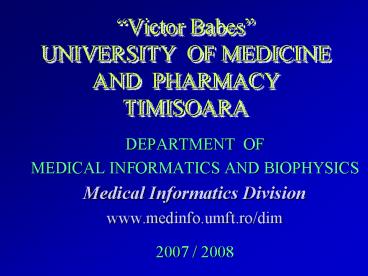Title:
1
Victor Babes UNIVERSITY OF MEDICINE AND
PHARMACY TIMISOARA
- DEPARTMENT OF
- MEDICAL INFORMATICS AND BIOPHYSICS
- Medical Informatics Division
- www.medinfo.umft.ro/dim
- 2007 / 2008
2
CORRELATION ANALYSISEPIDEMIOLOGY
- COURSE 6
3
- 1. RELATIONS BETWEEN TWO QUANTITATIVE VARIABLES
. - 1.1. DEPENDENCY DEGREE .
- STATE SPACE (DIAGRAM)
- 1 INDIVIDUAL 1 POINT
4
a) INDEPENDENT VARIABLES HG hemoglobin
concentration h height
5
b) DEPENDENT VARIABLES Causal relation -
mathematical model O2 in the blood -
atmospheric pO2
6
c) CORRELATED VARIABLES G weight, h height
7
- 1.2. LINEAR CORRELATION
- a) CORRELATION COEFFICIENT (Pearson)
- rxy sxy / sx sy
- sxy covariance
- sx variance of x
- sy variance of y
8
- b) PROPERTIES
- VALUES -1, 1
- r gt 0 gt DIRECT CORRELATION
- r lt 0 gt INVERSE CORRELATION
- WEAK / STRONG CORRELATION
- WEAK CLOSE TO 0
- STRONG CLOSE TO -1 OR 1
- TESTING r WITH t TEST - significance
9
Direct and inverse correlations
10
1.3. REGRESSION LINE(best line among the
points)
- a) EXAMPLE
- HEIGHT CHILDREN - PARENTS
- hc gt hp
- SLOPE lt 1 gt REGRESSION
- TENDENCY TOWARDS MIDDLE REGION
- b) LINE PARAMETERS y a b x
- a INTERCEPT
- b SLOPE
11
1.5. NONLINEAR CORRELATIONS
- a) EXPONENTIAL
- y a . e b.x
- Increasing (b gt 0) ABSORBTION
- Decreasing (b lt 0) CLEARANCE
12
- b) LOGARITHMIC
- y a b . log x
- WEBER - FECHNER LAW (Sensation)
- c) POWER
- y a . x b
- STEVANS LAW (Neural frequency)
13
- d) HYPERBOLIC
- (x - a) . (y - b) k
- HILL LAW (Muscular contraction), ABBEY
- e) LOGISTIC
- y a . x / (k x)
- MICHAELIS - MENTEN (Enzymatic kinetics)
- ARIENS (Dose - response curves)
14
2. CORRELATIONS FOR ORDINAL VARIABLES
- 2.1. RANK CORRELATION COEFFICIENT
- SPEARMAN R
- Comparing two classifications
- 2.2. KENDALL CORRELATION COEFFICIENT
- Appl. for ordinal and nominal variables
15
2. EPIDEMIOLOGICAL BIOSTATISTICS
16
1. RISK ANALYSIS
- 1.1. RISK FACTORS
- a) DEFINITION
- Hypothetical cause for disease occurrence or
facilitation - b) CLASSIFICATION
- Environmental
- Social
- Behaviorial
- Biological
17
1.2. DATA TABLES (Contingency tables)
18
- 1.3. METHODS
19
- 1.3. METHODS
- A- EXPERIMENTAL
- RISK FACTOR CONTROL
- DISADVANTAGE ETHICAL REASONS
- B- OBSERVATION-BASED
20
- a) CROSS - SECTIONAL
- TRANSVERSAL Moment situation in a large sample
- b) COHORT - PROSPECTIVE
- LONGITUDINAL
- Two groups Exposed / Unexposed
- c) COHORT - RETROSPECTIVE
- d) CASE - CONTROL
- Two groups Disease / No-disease
- e) Comparison
- EXP gt COH.pr. gt COH.ret. gt CASE-C. gt CR.S.
21
(No Transcript)
22
- 1.4. FONDAMENTAL PARAMETERS IN EPIDEMIOLOGY
- ODD INDEX (success / fail)
- ODD (E) N11 / N12
- ODD (E-) N21 / N22
- ODDS RATIO (OR)
- OR ODD(E) / ODD(E-)
- OR N11 . N22 / N12 . N21
23
- ABSOLUTE RISK (success rate)
- R (E) N11 / L1
- R (E-) N21 / L2
- RELATIVE RISK (RR)
- RR R(E) / R(E-)
- RR N11 . L2 / N21 . L1
- Usually OR gt RR
- IF OR gt 1 (RR gt 1) gt RISK !
24
3. SURVIVALANALYSIS
25
- 1. CHARACTERISTICS
- missing data, long duration of study
- heterogenous conditions
- several influencing factors
- 2. DATA PROCESSING
- life tables
- actuarial method
- Kaplan Mayer curves
26
Data collection
27
Actuarial method
28
Kaplan Mayer plots
29
- 3.3. INDICATORS
- Life Years (Survival years)
- QoL Index Quality of Life
- Adjusting Life Years to QALY (Quality Adjusted
Life Years)
30
- e n d -































